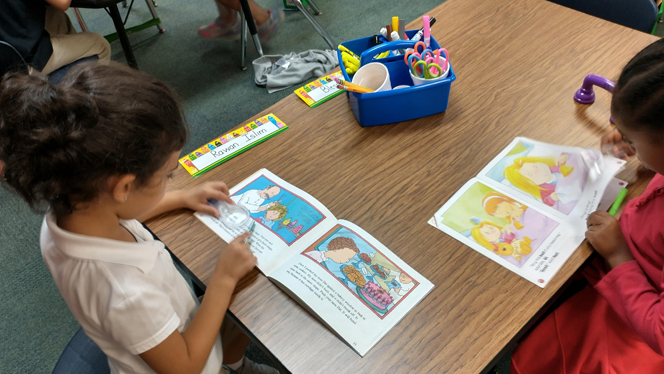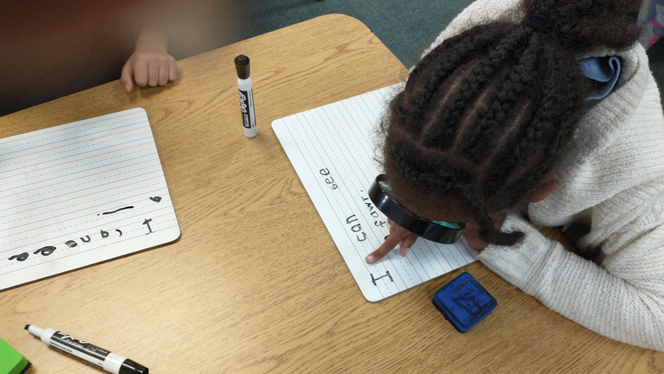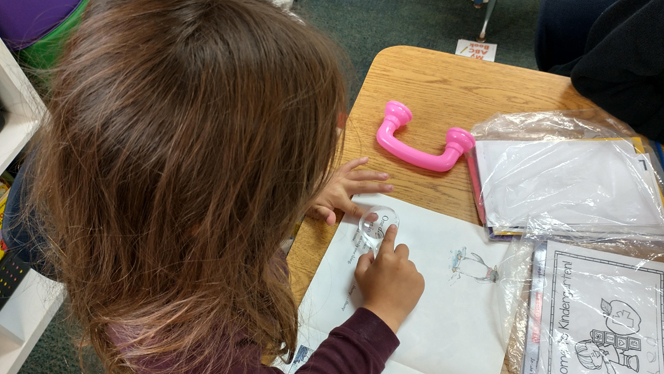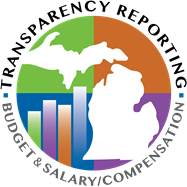“When young ones are very first learning to read, they rely heavily on the pictures to read and retell the story,” Oswalt said. “They often do not recognize or notice the text on the page. The jumble of letters, once they know what they are called, have no meaning in these early literacy phases.”
Oswalt just recently introduced the magnifying glass to the students. It is a fun way to put text in focus for a beginning reader. Looking for small things is not as overwhelming as seeing all the words on the page.

The magnifying glass helps scholars slow down as they read; each word should fill the glass.
“Being able to find a letter or word the students have been learning about builds confidence and motivates students to keep looking,” Oswalt said. “Just like a detective might use a magnifying glass to search for clues, readers use the sounds that letters make to give us the clues they need to decode a word. Until they build automaticity, we want them focused on the sounds.
“At first, we look for upper case letters, lower case letters, and eventually search for words we are learning. I use the magnifying glass to identify the beginning and end of a sentence. We notice how spaces between words make it easy to read. I call these ‘meatball spaces.’”
Oswalt uses the magnifying glass in other ways, as well. She finds editing is easier with a magnifying glass. Young ones have a difficult time finding things to fix in their writing.
“They just think it is done,” Oswalt said. “However, when they work with a partner to edit, they use the magnifying glass to show their partner uppercase letters at the beginning of a sentence, all lowercase letters in the middle of a word, space between words, word wall words spelled correctly, and proper punctuation. If they can’t find these things when they look ‘real close’ with the magnifying glass, it means they need to add or correct something.”

This student uses her magnifying glass to help her go back to edit what she has written.
Oswalt finds the magnifying glass gives her students a purpose for looking away from the picture and focusing on a letter, word, or even punctuation.
“One student was writing the sentence ‘I can see,’” Oswalt said. “His first try had the words smashed together. I gave him the magnifying glass and asked him to search for the spaces between his words. He said he could not find them. The fix was to make a finger space and rewrite the sentence. He wrote the corrected version with the first try. I showed the class his work and we read his sentence together. My kids spontaneously started clapping for him. It was a sweet moment.”
For older grades, magnifying glasses can be used to search for root words, special endings/beginnings, isolating syllables for longer words, and hunting for dialogue tags to practice character voice.
“I tutor a student with dyslexia, and we use the magnifying glass to zoom in on the first sound before reading across the word,” Oswalt said.

When students use the pink whisper phone and say a sound like a “p,” they can really hear the correct way to say it. Also, the phones allow 25 kids to quietly read in a room.
Using a magnifying glass helps students with directionality as well. Moving the magnifying glass to the right along the line of words, counting the words in the sentence, and learning how to scoot back and move down a line to continue reading are fun skills to practice.
“What I tell my students when I introduced the magnifying glasses, and whenever I ask them to get them out, is ‘Let's take a closer look at …’” Oswalt said. “It is a tool my students and I love to use.”
Congratulations Mrs. Oswalt for helping your students learn in a fun and unique way.
About South Arbor Charter Academy
South Arbor Charter Academy is a tuition-free, public charter school in Ypsilanti, Michigan, serving students in Young 5s through eighth grade. It is part of the National Heritage Academies network, which includes more than 100 tuition-free, public charter schools serving more than 65,000 students in kindergarten through 12th grade across nine states. For more information, visit nhaschools.com.
Visit South Arbor Charter Academy's blog to read more stories like this.
